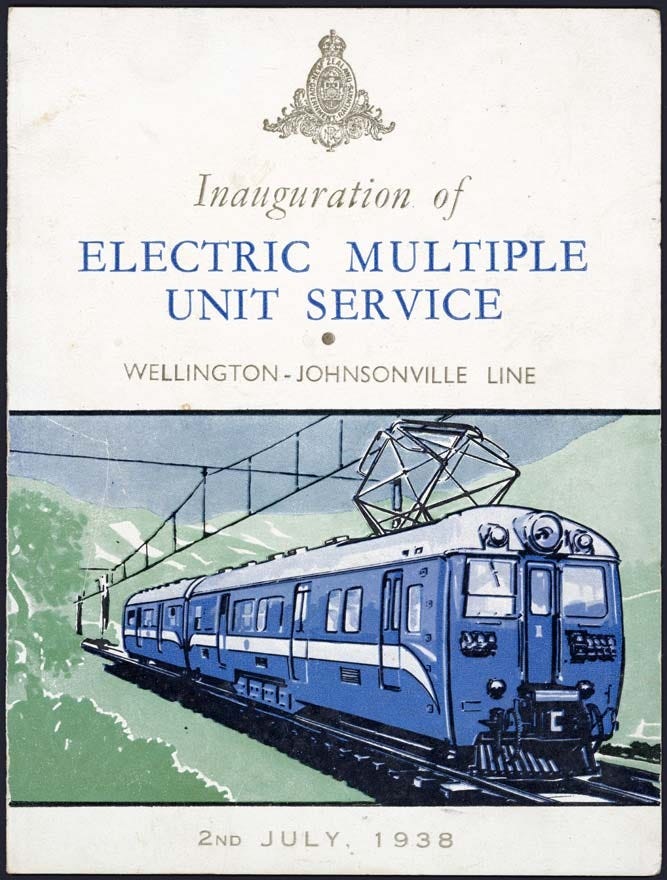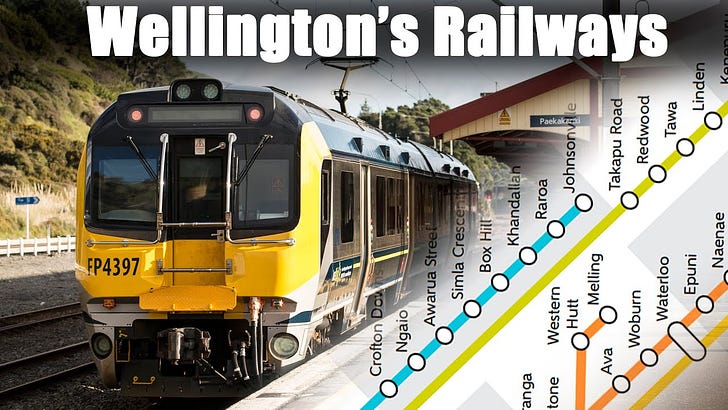Time for investment in the capital's rail
Wellington has traditionally been Aotearoa's rail capital. But the city's growth is straining its rail network. Read on for what is needed to secure Wellington's rail future.
The story thus far
Wellington has traditionally had the best developed and most used public transport network in Aotearoa. As at the 2018 Census, 18% of workers and 21.7% of students used public transport to get to travel to work or study compared to the national average of 6.4% of workers and 19% of students1. This is supported by a strong linear rail network, supportive geography and a very strong city centre with around 40% of the entire region’s employment.
If you are not familiar with Wellington’s urban rail network, I strongly recommend this Youtube video by Taitset as an excellent explainer.
Wellington has also traditonally been the only city in Aotearoa to have sustained investment in urban rail in the 20th Century. 1937 saw the Tawa Deviation opened as a much faster route north from the capital as well as the opening of the new Wellington Railway Station. In 1938, the Johnsonville Line was electrified and new rolling stock introduced, while two years later in 1940, the Kāpiti line was electrified as far as Paekākāriki.

The housing crisis at the end of World War Two led to the suburbanisation of Te Awakairangi/ Hutt Valley with a new route for the Hutt Valley Line constructed from Waterloo through new housing developments in Naenae and Taitā and electrified in stages from 1946 to 1955 as far as Upper Hutt.
After this, progress was slower with key developments being:
1957 to 1961. Tawa to Plimmerton double-tracking and track straightening alongside Porirua Harbour.
1982. Introduction of Ganz-Mavag electric multiple units.
1983. Extension of the electrified suburban network on the Kāpiti Line from Paekākāriki to Paraparaumu and double-tracking as far as Mackays Crossing.
2010. Introduction of Matangi electric multiple units to replace the Ganz Mavags.
2011. Further extension of the electrified suburban network on the Kāpiti Line from Paraparaumu to Waikanae and double-tracking from Mackays Crossing to just south of Waikanae.
2021. Completion of double-tracking on the Hutt Valley Line between Trentham and Upper Hutt.
While investment in rail continued in Wellington, the fact that the majority of the investment was in the 1930s to 1950s, combined with the systematic decline of Aotearoa’s rail network since then, meant that by early this century the network itself was in pretty poor shape.
Some upgrades have taken place in the network over the past decade, including remasting the electrified network, replacing signal boxes with automatic colour light signalling and replacing wooden sleepers with more resilient concrete sleepers.
But as you can see in the graphic above, this work is largely about catch-up renewals to bring the rail network back to a state of good repair, rather than significant investment in network capacity, apart from the Plimmerton Station turnback platform and the recently completed double-tracking from Trentham to Upper Hutt on the Hutt valley Line.
So while Wellington has a solid and well-used rail network, it is still recovering from decades of neglect and under-investment, lacks resilience and most importantly, lacks capacity for growth.
A growing region
This lack of rail network capacity for growth is a real issue as 74% of Wellington’s regional growth is projected to happen along the Kāpiti and Hutt Valley rail lines. Particularly important is the 43% of growth projected to occur on the Kāpiti Line and in Horowhenua on the Western Growth Corridor. While the Hutt Valley Line, on the Eastern Growth Corridor, is now fully double-tracked to Upper Hutt, the Kāpiti Line has single-track sections between Pukerua Bay and Paekākāriki (the so-called North-South Junction section) and on the approach to Waikanae Station which limits Kāpiti Line service to every 20 minutes, severely constraining its ability to serve growth.

Put simply, the recently completed double-track of the Hutt Valley Line means that frequency improvements don’t require major infrastructure investment apart from the fourth main line into Wellington Station. This project will separate the Hutt Valley and Kāpiti Lines, meaning more capacity for each line and more network resilience as issues on one line won’t cascade onto other lines.
The Kāpiti Line requires significantly more investment because of the scale and location of growth at the northern end of the region and because of the significant network constraints caused by the remaining single-track sections which are the weakest links in the network.
The weakest link
The Lower North Island suffers from significant resilience challenges and the weakest link is the single-track North South Junction section of the Kāpiti Line below the steep and unstable Paekākāriki Escarpment. A major slip in 2021 derailed an urban passenger train in this section and led to the installation in 2023 of 20 sensors on the Kāpiti Line between Plimmerton and Paekākāriki including slope movement and debris sensors, rain gauges, soil moisture metres and night vision cameras2. This makes this section of track the weakest link in the Lower North Island supply chain. The parallel state highway has recently between supplemented by the Transmission Gully Motorway to provide additional resilience. While replacing this section of track with a more resilient double-track corridor is likely one of the big ticket items in the Programme Business Case, doing this would bring rail up to a higher level of resilience as is provided for roads by the Transmission Gully Motorway. As well as enabling rail-served growth in Kāpiti, Horowhenua and the Manawatū.
As I said in my MRCagney blog post, Thinking more broadly around resilience, resilience that only focuses on reinforcing or expanding key vulnerable links in the state highway network just doubles down on and reinforces car dependency and does not create resilience through mode choice. And this particularly applies to Wellington’s rail network and its weakest links.
The key moves
The Wellington Rail Programme Business Case, the capital’s strategic rail plan for the next three decades, was finalised in 2022. It presents a clear, logical and well-staged approach to addressing the key constraints in the Wellington rail network and provides a strong platform for rail to play a major role in servicing growth in the Hutt Valley, Kāpiti and Horowhenua. At the same time, it provides more train slots for regional services to the Wairarapa and the Manawatū, freight services and current and future long-distance passenger rail services.
The programme includes a wide range of improvements including:
Frequency improvements, from the current 20-minute peak frequency to a 15-minute, then 10-minute and finally 6-minute peak frequency at most stations on the Hutt Valley and Kāpiti lines (and even higher at major stations). Interpeak services are increased to every 15 minutes and there will be more frequent services on the Wairarapa and Manawatū lines.
Double-tracking between Pukerua Bay and Paekākāriki (North-South Junction), a key single-track constraint severely limiting train frequency in Kāpiti, Horowhenua and Manawatū.
Third main line in the Tawa Valley, which will enable higher passenger frequencies and improve service resilience and reliability on the Kāpiti Line.
Double-track approach to Waikanae Station, including a bridge and second platform, enabling more frequent trains on the Kāpiti and Manawatū lines.
35 kilometres of double-track in Horowhenua to enable more frequent regional and long-distance passenger services and reduce conflict with freight services.
Electric multiple unit fleet expansion from 166 to 366 cars by 2048.
Wellington Station capacity improvements including a fourth main track to enable the separation of Hutt and Kāpiti lines, northern access to EMU stabling, and separated access to the Wellington freight terminal.
Station improvements including to accessibility, shelter, and information and station access improvements making active and public transport more attractive as access modes.

All of these improvements don’t come cheap with the programme costed at just shy of $10 billion. But as always, the question is not so much the cost of doing this as the cost of not doing this to provide genuine transport choice in growth areas and for Wellington to maintain its tradition of strong passenger rail service.
“the question is not so much the cost of doing this as the cost of not doing this”
Final thoughts
Wellington has always shown the rest of Aotearoa that enforced car dependency is a political choice, not manifest destiny. Its rail network is key to the city’s ability to function as a political, economic, educational and culture centre.
But sadly, its railway network has, like in the rest of Aotearoa, be allowed to slowly decline over several decades in spite of more investment than elsewhere.
Most growth in Wellington is taking place in rail served corridors, giving rail a great opportunity to play an even bigger role in the capital’s transport future.
There is a good plan in place for Wellington’s rail network to play an even more important role in providing rail service to key growth areas.
There is a big price tag to this investment, but an even bigger price tag to not doing so. We are in the midst of a climate crisis where Aotearoa can only meet its legislatively mandated commitment to net zero emissions by 2050 through a radical shift away from car dependency to genuine transport choice to sustained investment in active and public transport.
As always with the big shifts needed to address the climate crisis, the time to act is right now.
Place Summary for Wellington Region, Tatauranga Aotearoa/Stats NZ
Eyes on potential slips along Kāpiti Line as new system goes online, Stuff, 30 May 2023






Interesting. How much of the required/planned upgrades and improvements are happening because of the planned improvements to the Wellington - Palmerston North and Wellington - Masterton (commuter) passenger services.
Most likely that these will occur because it is already committed to by this government and included in the National Party's moar roads transport announcement.
The future looks bleaker for Te Huia though despite it also running along a major development corridor.
Great commentary, as far as it goes.
But unfortunately, it doesn't go south of Bunny St and include the region's CBD, a quarter of the population, three quarters of the economic activity, the densest areas and important regional destinations like the main hospital and the airport. Every other main urban rail system in the world (as far as I can determine) provides an unbroken direct through service between the suburbs and satellite cities and through the dense core – the reason for Auckland's City Rail Link, for example. Providing a direct through service and eliminating the stub termination at the edge of the CBD would be a far more effective way to provide extra capacity, and incentivising passengers to use it, than simply improving the railway which will still stop short of the destinations typically sought by car commuters.
Plans to fix this anomaly in Wellington, using light rail/tram-train, have been around since 1878, as I outlined in a presentation to the NZ Rail 2014 conference in Auckland. I would attach it, but there seems no facility for us freeloaders to do so (and on a superannuitant's budget I am prevented by my manager from taking out a paid sub!!) But I will happily answer emails.
Brent Efford, NZ Agent, Light Rail Transit Assn brent.efford@me.com